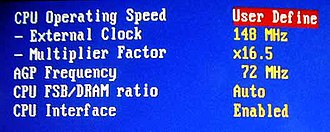This article possibly contains original research. (February 2023) |

In computing, overclocking is the practice of increasing the clock rate of a computer to exceed that certified by the manufacturer. Commonly, operating voltage is also increased to maintain a component's operational stability at accelerated speeds. Semiconductor devices operated at higher frequencies and voltages increase power consumption and heat.[1] An overclocked device may be unreliable or fail completely if the additional heat load is not removed or power delivery components cannot meet increased power demands. Many device warranties state that overclocking or over-specification[2] voids any warranty, but some manufacturers allow overclocking as long as it is done (relatively) safely.[citation needed]
- ^ Victoria Zhislina (February 19, 2014). "Why has CPU frequency ceased to grow?". Intel. Archived from the original on June 21, 2017. Retrieved August 2, 2017.
- ^ "LIMITED WARRANTY" (PDF).